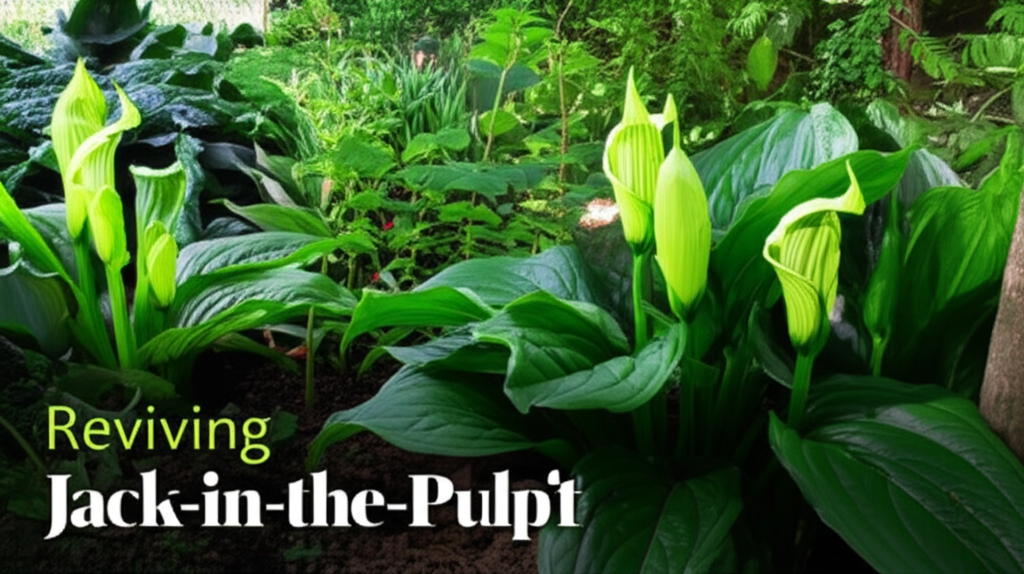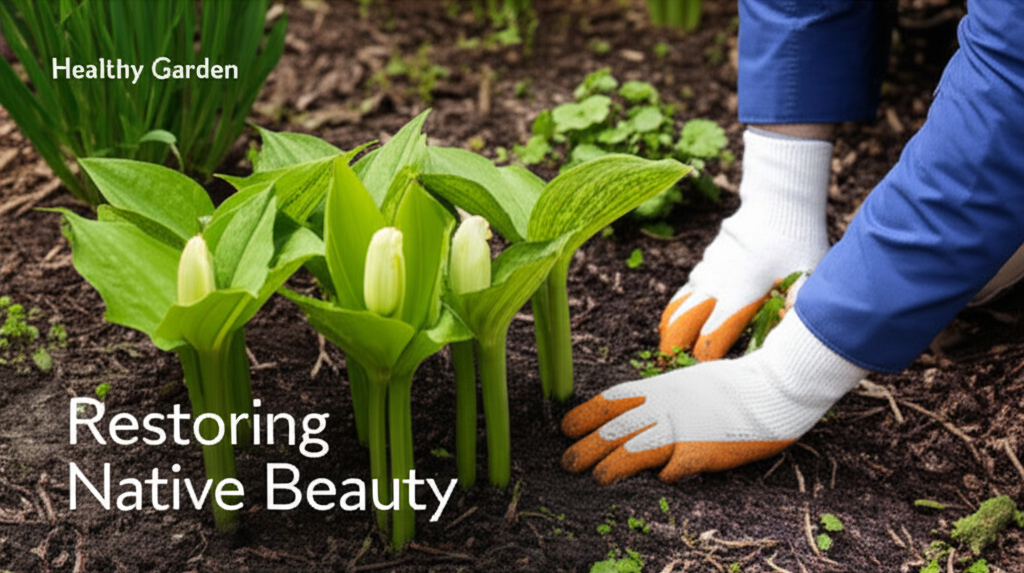Unearthing the Beauty: A Guide to Jack-in-the-Pulpit Garden Restoration
The Jack-in-the-Pulpit (Arisaema triphyllum) is a captivating native woodland perennial, renowned for its unique hooded spathe and spadix, resembling a preacher in his pulpit. Its subtle beauty and ecological significance make it a prized addition to shade gardens. However, the delicate balance of its woodland habitat can be easily disrupted, leading to decline. This guide delves into comprehensive garden restoration techniques specifically for Jack-in-the-Pulpit, empowering gardeners to revive these enchanting plants and their environments.
Understanding the Jack-in-the-Pulpit’s Natural Habitat

Successful restoration hinges on understanding the native environment of the Jack-in-the-Pulpit. These plants thrive in:
- Moist, well-drained soil: Rich in organic matter, mimicking the forest floor.
- Partial to full shade: Protected from direct sun, especially during the hottest parts of the day.
- Understory conditions: Often found beneath deciduous trees, benefiting from leaf litter.
- Slightly acidic to neutral pH: Typically between 5.5 and 7.0.
The corm (a bulb-like underground stem) requires consistent moisture but is susceptible to rot in waterlogged conditions. Restoring these conditions is paramount for the plant’s survival and propagation.
Key Restoration Goals
When undertaking Jack-in-the-Pulpit garden restoration, consider these primary objectives:
- Re-establishing a healthy, self-sustaining population.
- Improving soil health and moisture retention.
- Creating an environment that discourages invasive species.
- Encouraging natural propagation and spread.
- Maintaining the aesthetic appeal of a woodland setting.
Assessing the Current State of Your Garden
Before implementing any restoration techniques, a thorough assessment of the existing garden is crucial. Observe:
Soil Conditions
- Texture: Is it sandy, loamy, or clay-heavy?
- Drainage: Does water pool after rain?
- Organic Matter Content: Is there a good layer of leaf litter or compost?
- Soil pH: If possible, conduct a soil test.
Light Exposure
- How much direct sunlight does the area receive throughout the day and across seasons?
- Are there overhanging branches that need management?
Plant Community
- Are Jack-in-the-Pulpit present? If so, what is their health and density?
- What other plant species are growing in the area? Are there invasive species present?
- Are there signs of pests or diseases?
Essential Restoration Techniques
Based on your assessment, you can implement a range of targeted restoration techniques.
Soil Improvement Strategies
The foundation of successful Jack-in-the-Pulpit restoration lies in enriching the soil. This often involves a multi-pronged approach:
- Adding Organic Matter: Incorporate compost, well-rotted leaf mold, or aged manure. This improves soil structure, water retention, and nutrient availability. Aim for a layer of 2-3 inches.
- Improving Drainage: If the soil is heavy clay, consider adding coarse sand or grit to improve aeration and drainage. Raised beds can also be an option in severely waterlogged areas.
- Mulching: A layer of organic mulch, such as shredded bark, pine needles, or leaf litter, is vital. Mulch helps retain soil moisture, suppress weeds, regulate soil temperature, and gradually adds nutrients as it decomposes.
- pH Adjustment: If your soil is too alkaline, incorporate acidic organic matter like peat moss (use sustainably sourced where possible) or pine bark. For soil that is too acidic, add lime sparingly according to soil test recommendations.
Light Management
Jack-in-the-Pulpit requires dappled shade. If your garden is too sunny:
- Prune Overhanging Branches: Selectively prune the lower branches of mature trees to allow more dappled light. Avoid excessive pruning that could harm the tree.
- Plant Shade-Providing Species: Introduce complementary native plants that naturally thrive in shade, such as ferns, hostas, or woodland wildflowers.
- Consider Temporary Shade Structures: In extreme cases, temporary shade cloth might be necessary during the initial establishment phase of new plantings.
Conversely, if the area is too shaded due to dense canopy, controlled pruning of trees may be beneficial.
Controlling Invasive Species
Invasive plants can outcompete native species like the Jack-in-the-Pulpit for resources. Effective control methods include:
- Manual Removal: Digging out invasive plants by the root is often the most effective method. Ensure you remove the entire root system to prevent regrowth.
- Smothering: For large areas with aggressive groundcovers, consider using landscape fabric or cardboard covered with mulch to suppress growth.
- Targeted Herbicide Use (with caution): In severe cases, carefully consider the use of herbicides, following label instructions precisely and targeting only the invasive species. This should be a last resort, especially in a sensitive ecosystem.
- Regular Monitoring: Consistent vigilance and early detection of new invasive sprouts are key to long-term success.
Encouraging Natural Propagation
Jack-in-the-Pulpit reproduces both vegetatively (through corms) and by seed.
- Allow Seed Pods to Mature: After flowering, the Jack-in-the-Pulpit produces a cluster of bright red berries. Leave these on the plant to mature and disperse their seeds naturally.
- Natural Seed Dispersal: Birds and small mammals often consume the berries and aid in seed dispersal.
- Avoid Over-Disturbing: Refrain from excessive digging or soil disturbance in areas where you want the plants to spread naturally, as this can disrupt the delicate corm structure and hinder seed germination.
Reintroducing Jack-in-the-Pulpit
If your garden lacks existing plants, you can introduce them:
- Source Responsibly: Obtain plants from reputable native plant nurseries or propagate from collected seeds or divisions. Never dig up wild plants.
- Planting Corms: Plant corms in late fall or early spring, about 4-6 inches deep, with the pointed end (if visible) facing upwards.
- Planting Seeds: Jack-in-the-Pulpit seeds often require a period of stratification (exposure to cold and moisture) to germinate. Sow seeds in pots and place them outdoors in a protected location to experience winter conditions. Germination can take one to two years.
Ongoing Maintenance for Long-Term Success
Restoration is not a one-time event; it requires ongoing commitment.
Seasonal Care
- Spring: Gently remove any accumulated debris, being careful not to disturb emerging shoots. Replenish mulch if necessary.
- Summer: Water consistently during dry periods, especially for newly planted corms. Ensure adequate shade.
- Fall: Allow foliage to die back naturally. This process sends vital energy back into the corm for the following year. Add a fresh layer of organic mulch.
- Winter: The dormant corm is protected by the mulch layer.
Monitoring and Adaptive Management
Regularly observe your restored garden:
- Check for signs of pests or diseases.
- Monitor for the return of invasive species.
- Assess the health and spread of the Jack-in-the-Pulpit population.
- Be prepared to adjust your techniques based on what you observe.
Key Facts and Comparison Table
This table highlights crucial aspects of Jack-in-the-Pulpit care and restoration compared to general shade garden practices.
| Feature | Jack-in-the-Pulpit Restoration Needs | General Shade Garden Needs |
|---|---|---|
| Soil Moisture | Consistently moist, well-drained, rich in organic matter. Sensitive to waterlogging. | Varies by plant, but often requires good drainage. Can tolerate drier conditions than Jack-in-the-Pulpit. |
| Light | Dappled to partial shade. Protect from harsh afternoon sun. | Ranges from full shade to partial sun depending on the plant species. |
| Organic Matter | High. Mimics forest floor, crucial for corm health. | Beneficial for most shade plants, improves soil structure. |
| Invasive Control | High priority. Invasive species directly compete and can eradicate native populations. | Important for overall garden health and aesthetics. |
| Propagation | Natural seed dispersal and corm division. Patience required for seed germination. | Varies greatly by plant species; some are vigorous self-seeders, others require specific propagation techniques. |
Step-by-Step Restoration Process and Considerations
The following table outlines a typical restoration process, along with potential benefits and drawbacks of each step.
| Step | Description | Pros | Cons |
|---|---|---|---|
| 1. Assessment | Evaluate soil, light, and existing vegetation. Identify invasive species. | Provides a clear understanding of the site’s needs; informs strategy. | Can be time-consuming; requires observational skills. |
| 2. Invasive Species Removal | Manually remove unwanted plants, ensuring root removal. | Reduces competition for native plants; allows them to thrive. | Physically demanding; requires persistence. Incomplete removal can lead to regrowth. |
| 3. Soil Amendment | Incorporate compost, leaf mold, or aged manure. Improve drainage if necessary. | Enhances soil fertility, moisture retention, and structure, creating an optimal environment. | Requires effort and materials. Over-amending can sometimes alter soil structure negatively if done incorrectly. |
| 4. Mulching | Apply a layer of organic mulch (e.g., shredded bark, leaf litter). | Conserves moisture, suppresses weeds, regulates soil temperature, adds nutrients. Protects corms. | Can harbor slugs or snails if too thick and applied directly against plant stems. |
| 5. Light Adjustment | Prune trees or plant shade-providing species as needed. | Ensures ideal light conditions for Jack-in-the-Pulpit. | Pruning requires knowledge of tree health. Planting new species takes time to establish. |
| 6. Reintroduction (if needed) | Plant responsibly sourced corms or seeds. | Establishes or reinforces Jack-in-the-Pulpit populations. | Corms can be expensive; seeds require patience. Risk of transplant shock. |
| 7. Ongoing Monitoring & Maintenance | Regularly check for weeds, pests, and plant health. Replenish mulch. | Ensures long-term success and a self-sustaining ecosystem. | Requires consistent effort and vigilance. |
Troubleshooting Common Issues
Yellowing Leaves
Yellowing leaves can indicate several issues:
- Too much sun: Move to a shadier spot or increase shade cover.
- Too dry: Increase watering frequency, especially during dry spells.
- Poor drainage: Amend soil to improve aeration and drainage.
- Nutrient deficiency: Apply compost to enrich the soil.
Lack of Flowering
Several factors can prevent flowering:
- Young plants: Jack-in-the-Pulpit needs a few years to mature before flowering.
- Insufficient light: Ensure adequate dappled shade.
- Dormancy issues: Corms need a proper period of dormancy. Avoid disturbing them in late fall and winter.
- Over-disturbance: Avoid excessive digging around established plants.
Pest and Disease Management
While generally robust, Jack-in-the-Pulpit can occasionally be affected by:
- Slugs and Snails: These can chew on leaves and emerging shoots. Use slug bait (organic options are available) or handpick them.
- Fungal diseases: Often a result of poor air circulation or overly wet conditions. Ensure adequate spacing and good drainage. Remove any infected parts.
Conclusion: Nurturing a Woodland Gem
Restoring a Jack-in-the-Pulpit garden is a rewarding endeavor that reconnects us with the intricate beauty of native woodlands. By understanding their specific needs and applying thoughtful restoration techniques, gardeners can cultivate thriving populations of these unique plants, contributing to the health of local ecosystems and enjoying their captivating charm for years to come. Patience, observation, and a commitment to sustainable practices are the most valuable tools in this process.


